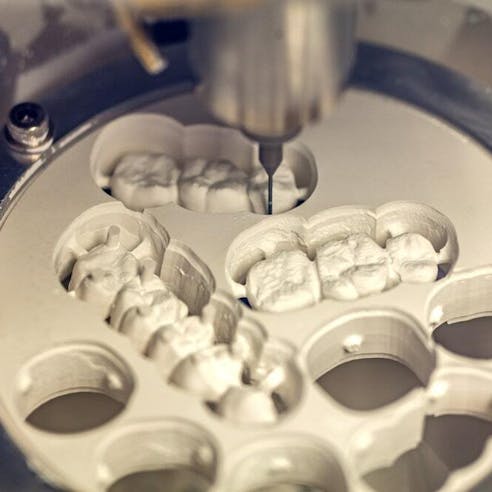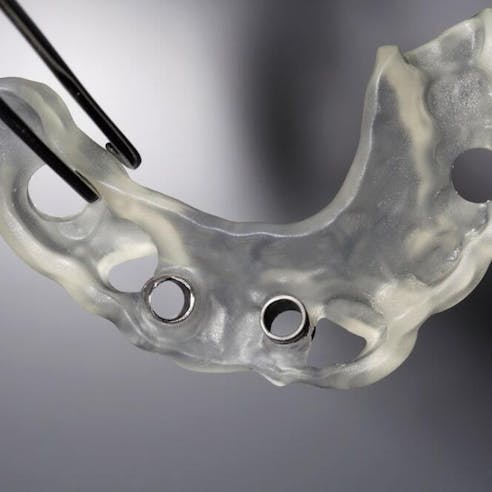Dental 3D Printing Service on Xometry
Get instant online quotes for 3D-printed dental parts in over 70 metal and plastic materials. Free shipping on all US orders. ISO 9001:2015, ISO 13485, IATF 16949:2016, and AS9100D certified.
Xometry offers high quality dental 3D printing services for a variety of materials and end uses within the dental industry. Using high-resolution technologies like stereolithography, digital light processing, material jetting, and other processes, Xometry can create personalized one-off dental tools built from biocompatible resins and polymers that exactly match each patient. Applications for 3D printing in the dental industry include digital dentistry workflows, alignment trays, implant models, dental models, surgical guides, tools for dental labs, partial or full dentures, and more.
Dental 3D Printing Technologies
Below are the main types of 3D printing technologies that are available through Xometry that are used in dental applications.
- Stereolithography (SLA)
- Digital Light Processing (DLP)
- Material Jetting
- Selective Laser Sintering (SLS)

Stereolithography (SLA)
Stereolithography (SLA) printing uses UV curable photopolymer resin and a UV light source to build parts in a layer-by-layer process. A computer guided precision beam of UV light draws the layer shape onto the build platform within the liquid photopolymer vat, curing the resin into a solid layer. After all part layers are solidified with support structures, the part is removed from the vat and washed in a solvent solution to remove uncured resin, and then receives a final post-cure in a UV light oven. SLA is an ideal choice to produce small objects like dental models that require accurate features and a smooth surface finish, such as those found in dental practices. Learn more on Xometry’s SLA 3D Printing Service page.
Digital Light Processing (DLP)
An update to SLA 3D printing technology, DLP (digital light processing, sometimes found as continuous digital light manufacturing) is a 3D printing technology that implements a projector and a DMD (digital mirror device, or an array of tiny mirrors) to selectively cure photopolymer resin one layer at a time. DLP technology is even higher resolution than SLA, and can sometimes outpace it in build time, making it a massive improvement from the original technology. DLP printers are extensively used in the dental industry to produce anatomically accurate dental models, surgical guides, orthodontic models, and custom-fit prosthetics. Learn more on our page for All About DLP 3D Printing.
Material Jetting
Also known by trademarked names PolyJet 3D printing or NanoParticle jetting, material jetting 3D printing is a set of 3D printing processes whereby material (UV curable resin, liquid polymer or other material) is sprayed onto a build platform in a similar manner to how ink from a 2D printer is sprayed onto paper. If necessary, the printhead will also expose the material to UV light to cure it into a solidified shape, and this process repeats until the full print is completed and ready for post-processing steps. The nature of material jetting processes results in the highest practical resolutions in all three axes, and it can also produce the most colorful prints with a full color spectrum of dyes to choose from. Material jetting is ideal for colored and precise parts used for medical visualization models of organs and structures within a patient built directly from imaging scans. Learn more on Xometry’s PolyJet 3D Printing Service page or our page All About PolyJet 3D Printing.
Selective Laser Sintering (SLS)
Selective laser sintering (SLS) is a newer powder bed fusion 3D printing technology often thought of as an offshoot from direct metal laser sintering (DMLS). Both processes work by utilizing a laser to precisely fuse a bed of powder to construct a part from a 3D CAD file. SLS is unique in that it specializes in nylon or polyamide powder particles to create parts, however it has access to a wide range of plastic, metal, and ceramic powders. In dentistry SLS is used to create metal crowns and bridges out of precious non-oxidizing metals, or to create a variety of dental models and surgical tools. Learn more on our page for SLS 3D Printing.
Need 3D Printed Dental Parts?
Dental 3D Printing Applications
3D printing technology has opened up an entirely new field of digital dentistry, where dental 3D printers help medical practitioners to heal patients. Here are some common dental applications of additive manufacturing used by dental professionals.
- Crown/Bridge Models
- Clear Aligner Models
- Surgical Guides
- Splints/Occlusal Guards
- Patterns for Casting and Pressing
- Hawley Retainers
- Full Dentures

Crown/Bridge Models
No longer do dentists need to shape crowns or bridges while they are being installed in the mouth–3D printing can take scans from a patient and create a highly detailed digital model of the space, allowing designers to print the exact shape crown or bridge that will fit the patient’s bite and smile.
Clear Aligner Models
Aligner models are less invasive and less painful than traditional braces when correcting a patient’s teeth, and this is directly thanks to 3D printing technologies that can integrate into digital dentistry workflows. Designers take scans of existing teeth, develop a 3D modeled pathway towards a corrected bite, and then print out a series of sequential alignment trays to gradually guide the teeth into place over time. The high resolution, smooth finish, biocompatibility, and clarity of 3D printed trays make these alignment trays more comfortable, easier to clean, and more aesthetically pleasing than traditional alignment technology.
Surgical Guides
Oral surgery is a constrained, difficult process that is uncomfortable for both the patient and the practitioner. 3D printed surgical guides not only reduce the chance for error by guiding tools exactly where they need to go, but they help minimize the equipment needed in the mouth to ensure safety and effectiveness. Surgical guides conform exactly to patient anatomy and bound tools like drills to a certain location, angle, and even depth, increasing the chances of success and the speed of care.
Splints/Occlusal Guards
Occlusal (a term for the chewing surfaces on teeth) guards or splints are easily made with dental 3D printers to provide cushioned, protective coverings for those who grind or clench during sleep. For only a few dollars worth of materials and just a few days' time, dentists can provide patients with occlusal trays that will keep their smile safe throughout the night.
Patterns for Casting and Pressing
Dental labs will typically take impressions or pressings of teeth periodically to update a patient’s medical record – however these are difficult to integrate into digital records as well as into other digital dentistry tools. With dental 3D printers, dentists can scan a patient's mouth, bring this scan into a CAD software, design the exact pattern needed for the affected area, print the part, cast or press it into the correct shape as per typical casting or pressing procedures, and then provide them to the patient. Additive manufacturing significantly improves the workflow of pattern making for casting and pressing, and gives the patient a personalized, perfect-fit product.
Hawley Retainers
Hawley retainers hold teeth position by stabilizing them while the bone hardens around them. They are worn all day and night for several months, making their comfort of paramount importance for patients. As a result, their manufacture is laborious, expensive, and difficult to scale using traditional methods. With 3D printing, designers can more efficiently produce Hawley retainers and keep them up to date with patient improvements without sacrificing quality or increasing treatment time. Dentists can serve more patients over time with little initial investment costs, while also providing more accurate and comfortable retainers.
Full Dentures
3D printing can produce full monolithic denture try-ins in as fast as a few hours, allowing dentists to test bite alignment, occlusal functionality, and comfort for only a few dollars worth of material. Temporary dentures can also be printed using biocompatible materials so that patients can keep their smile while they wait for traditional dentures or use them as a cost-effective alternative for those who cannot afford traditional dentures.
Why Choose Xometry for Dental 3D Printing?

Endless Options
Choose from millions of possible combinations of materials, finishes, tolerances, markings, and certifications for your order.

Easy to Use
Get your parts delivered right to your door without the hassle of sourcing, project management, logistics, or shipping.

Quality Assurance
We are ISO 9001:2015, ISO 13485, IATF 16949:2016, and AS9100D certified.